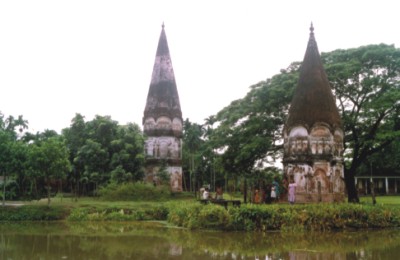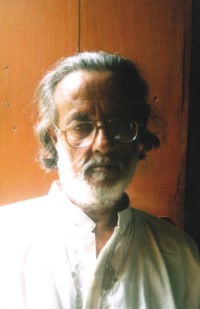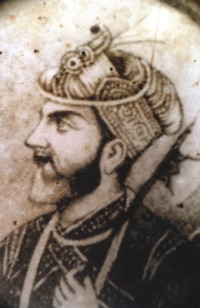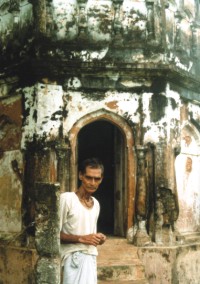Heritage
The
Rich Tradition of Kishoreganj
Khodeja
Sultana Lopa

Shiva
temple (right) in which Chandrabati used to pray next
to the Manasha temple |
Kishoreganj
a northern district of Dhaka, is enriched with archaeological
heritage.
At
first the city seems like any other district with lots of
rickshaws and narrow roads. Some locals inform us that the
city has not changed much in the last 15 years or so. The
people are very friendly and hospitable. There are many small
teashops here and there, full of customers and even people
you don't know will offer you tea.
The
river Norshunda flows across the city and people love fishing
even during normal working hours. In many places, many of
them can be seen sitting patiently with fishing hooks by the
river and also on bhelas (rafts).

Dewan
Amin Dau Khan, four-teenth ancestor
of Isa Khan |
People
are very proud of and talk a lot about their rich cultural
heritage. Poems of Chandrabati are a hot topic. They talk
very highly about Jangalbari, and about boating on the haor.
We decided to visit Chandrabati's house Jangalbari.
Chandrabati
is the first woman Bangali poet whose tragic life has touched
many hearts. She was born in the 16th century in a Brahmun
family. Her parents were Dija Bangshidash and Sholochona.
Chandrabati was guided by her father, another historical personality
well-known for his gathas or odes such as Mahua
and Komola.
Beautiful
Chandrabati was in love with a Brahmin boy called Joychandra.
The two were to get married when suddenly Joychandra jilted
her for another woman. Chandrabati, heart broken decided to
remain celibate all her life. Seeing her in such grief Chandrabati's
father advised her to occupy herself reciting the Ramayana
and in praying. Her loving father Dija also made a separate
Shiva temple for her to pray next to his manasha
temple.
Chandrabati
devoted herself to reciting and, writing odes and in praying.
Some of her well-known odes are: Malua, Dossho Kenaram
and Ramayana Katha (incomplete).

Isa
Khan |
Joychandra
soon realised that he still loved Chandrabati and tried to
win her back. As the legend goes, one day while Chandrabati
was praying in her closed-door temple, Joychandra came to
her begging to come back. As she was not opening the door,
Joychandra wrote a love letter on the temple wall with red
malati flowers. When Chandrabati opened the door,
it was too late-- Joychandra had committed suicide by drowning
himself in the river next to the temple. Chandrabati could
not bear this sight and she too took her own life.
Chandrabati's
ancestors still live in that village. The old building where
she used to live is partially used by another family. Her
study-cum-bedroom is now part of their home. We could not
visit that room but fortunately was able to meet her ancestor,
Tulshi Das, who continues to live in the other part of the
building. He regularly prays at the temple. That historical
river (some call it Puleshori, some call Bateshori) is now
dead , leaving behind a big canal in front of the temple.
The
government has declared these two temples as national heritage
sites, but conditions of these temples are worsening according
to Tulshi Das. He says that there is a school in Chandrabati's
name but the historical house, which was built by Dija, is
totally damaged.

Tulshi
Das, descendant of Chandrabati |
Das
hopes that the government and individuals will come forward
to repair this historical place and build a heritage museum
in memory of Chandrabati.
Jangalbari
Fort is another renowned historical place to visit in Kishoreganj.
It is situated in Jangalbari under Karimganj upazila.
The
crumbling fort seems to have a circular front. It was one
of the strongest outposts of Isa Khan. He built a number of
structures inside the fort. According to the locals, there
were 40 rooms in the fort that were mostly destroyed during
an earthquake in the year 1300 (Bangla calendar).
Ancestors
of Isa Khan moved to Jangalbari Fort from Sonargaon when Musa
Khan, son of Isa Khan, surrendered in the year 1611.
The
fourteenth ancestor of Isa Khan still lives in the fort. We
had the pleasure of meeting Dewan Amin Dau Khan and his daughters
and sons.
People
from different places come to visit this historical fort with
great interest. The baithakkhana, the outer part
of the fort, still has traces of its magnificent art work.
The ruining fort in ruins badly needs renovation and maintenance.
If the government could come forward to take care of this
historical place or to assist ancestors of Isa Khan then this
historical site could be saved.
Photos
by Md. Jahangir Alam
Copyright
(R) thedailystar.net 2005
| 